2019 BMW F 850 GS Vs Triumph Tiger 800 XCx Comparison Review

- The top-spec BMW F 850 GS Pro (Rallye colours) is priced at Rs. 15.3 lakh
- The top-spec Triumph Tiger 800 XCA is priced at Rs. 15.16 lakh
- The Tiger has a three-cylinder engine, while the BMW has a parallel-twin
The BMW F 850 GS meets the Triumph Tiger 800 XCx - two middleweight adventure bikes, both promising a level of capability that should meet all your two-wheeled adventure needs. Both are designed to cover long distances on tarmac, and to glide over the rough where the road ends. The Triumph Tiger 800 XCx is the popular choice, not just in India, but around the world too; the middleweight British adventure bike has an almost unmatched fan following, and it's an all-round great bike. The BMW F 850 GS boasts of German adventure lineage, renowned GS pedigree and top notch build quality and engineering. Even on paper, it seems like a tough choice, choosing one over the other. The question is - which one should you choose?
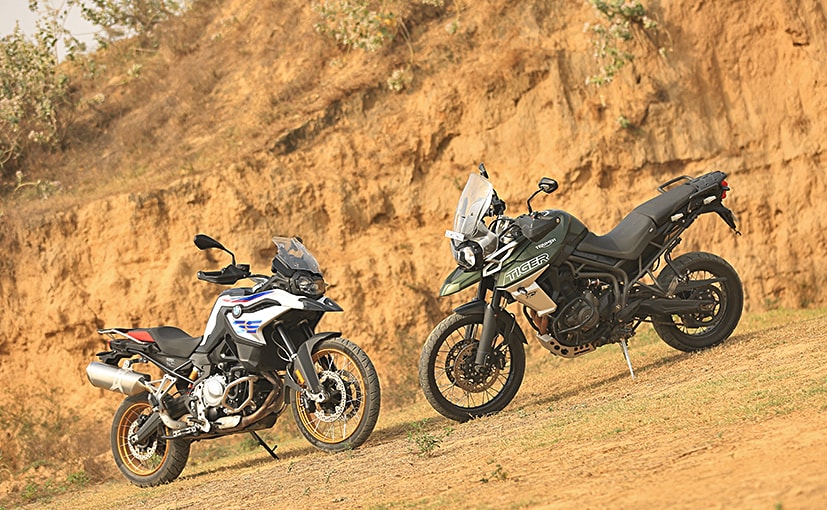
Both the BMW and the Triumph are tall, big and burly, and offer loads of presence as any ADV bike should be
Also Read: BMW F 850 GS Review
Design and Features
Both bikes seem to murmur promises of taking you beyond the horizon, where all that matters is the will to seek out adventure, and the attitude to explore more when tarmac disappears. They are big, burly and tall, and may look somewhat intimidating at first glance if you're not used to rubbing shoulders with big ADV bikes. But if it's one thing they have in spades, it's presence, not unlike a big, burly SUV, with somewhat similar capabilities. Fit and finish of the GS is top notch, and every small surface, every single component of the bodywork and chassis feels built to last, and speaks highly of quality. The 850 GS, particularly in the BMW Motorsport Rallye colour scheme of our test bike - in white, red and blue, is strikingly attractive, giving it a dash of sportiness. The Rallye colours also come with the gold coloured spoked wheels, adding even more flair and appeal. But keep in mind, opting for the Rallye colours and gold rims comes with an added cost.
Watch all the action in video here:

The full TFT instrument console is not standard. In fact, it costs Rs. 60,000
Our test bike also gets the optional TFT instrument panel, which isn't standard. So, you will need to shell out an additional Rs. 60,000 for that full-colour panel. The 850 GS is also available in three packages - Standard, Pro Low Suspension and the Pro, the top-spec package, and the one we're riding. The Pro variant gets LED headlamps, an additional Enduro Pro Riding Mode (along with Road and Rain), and the semi-active electronic rear suspension, which can be adjusted at the flick of a button. The Rallye colour option with the gold rims however, will set you back by an additional Rs. 30,000. While the base F 850 GS variant is available at Rs. 12.95 lakh (ex-showroom), the Pro variant in Rallye colours will cost Rs. 15.3 lakh (ex-showroom).
Also Read: Triumph Tiger 800 XCx Review

The Tiger's full colour TFT panel is standard and it's easy and intuitive to scroll through the menus
Comparatively, Triumph's off-road focussed middleweight adventure bike has two variants on offer - the Tiger 800 XCx, priced at Rs. 14.03 lakh (ex-showroom), and the top-spec Tiger 800 XCa variant, priced at Rs. 15.16 lakh (ex-showroom). The Triumph's overall silhouette has remained more or less unchanged over the last three generations, with some minor cosmetic updates. Now, it gets bolder graphics, slightly different ergonomics, and some updates to the engine and clutch. The Tiger also gets a standard aluminium sump guard which offers more protection when riding off-road, and the top-spec XCa offers a sixth, fully customisable riding mode (Rider) as well as standard heated grips, seat and auxiliary lights. The Tiger 800 XCx retails at Rs. 14.03 lakh (ex-showroom), while the top-spec XCa variant is priced at Rs. 15.16 lakh (ex-showroom). In terms of pricing, both are more or less evenly matched, but variant to variant, it's the Tiger which has more bang for your buck, although the Tiger misses out on tubeless tyres, which the GS gets as standard.

Both adventure bikes are almost evenly matched in the features list, but the Tiger looks a little too common, while the BMW offers exclusivity
In the electronics department too, the Tiger offers more versatility with several riding modes. For off-road newbies, there's the Off-Road mode, which offers limited wheel slip, but the safety of the traction control to rein a slide in when things begin to go out of control. The Off-Road Pro mode offers even more wheel slip for more experienced off-road riders. But every time you switch off the engine, the Tiger's mode selection goes back to default Road mode, which can be a bit of a minor irritant, because again you have to choose your preferred riding mode. On the standard F 850 GS, you only have Road and Rain, but in the Pro variant, you do get the Enduro Pro Mode which offers full customisation across throttle map, ABS and traction control settings, and your chosen settings will remain even when you need to switch off the bike. The top-spec Tiger 800 XCa also gets a fully customisable Rider mode which allows full customisation across all parameters - throttle map, ABS, and traction control.

The BMW is more eager at low revs, but offers limited wind protection in stock form, while the Tiger offers more refinement, and a superb soundtrack from its triple-cylinder engine
On the road
On specifications too, both bikes are more or less evenly matched. The India-spec BMW F 850 GS is slightly detuned to run on lower octane fuel. After all, how many fuel stations with high-octane fuel do you encounter once you're out of city limits? The F 850 GS is powered by a 853 cc, parallel-twin engine which puts out 90 bhp at 8,000 rpm and maximum torque of 86 Nm peaking at 6,250 rpm.. It may be manufactured by Longshing in China, but it's of high quality, and has the refinement and performance to make it immediately likeable. At the press of the starter, the parallel-twin comes to life with a very likeable 270-degree firing order rumble. And if you're over eager with the right wrist, the punchy motor can make the front wheel rear skywards very easily even in second gear. The mid-range is where the BMW feels most eager, and within the city, it's a hoot to ride.

The Tiger requires fewer downshifts even at highway speeds, and the three-cylinder engine is an absolute gem
The Tiger's 800 cc, in-line three-cylinder engine is smooth, refined and puts out 94 bhp of maximum power at 9,500 rpm, with 79 Nm of torque peaking at 8,050 rpm. What those numbers mean is that the Tiger has a high-revving engine, likes to be ridden hard, and has a superb soundtrack reminiscent of its supersport lineage. Yes, it's an adventure bike, but there's no mistaking the Tiger's sporty DNA. Ride quality is plush and comfortable, and you sit upright, with the tall windscreen keeping away any unwelcome wind blast when you're in the mood to cover several hundred kilometres over a day's ride. The torque peaking at high revs also means the Tiger's always rearing to go, even at highway cruising speeds; so, there's no need to downshift when just a twist of the wrist can get you ahead of any distracted driver at the wheel of a four-wheeler obstructing your path.

The BMW's strong mid-range offers easy manoeuvrability in off-road terrain
Off-Road Capability
Any true-blue adventure bike needs to have respectable off-road ability. And this is where both the Tiger 800 XCx and the F 850 GS boast of real off-road capability. Both bikes come with spoked wheels, with a 21-inch front and 17-inch rear combination. But the BMW has a definite advantage here, since it comes with standard tubeless tyres. The Triumph gets tubed tyres, so in the event of getting a flat tyre while on a two-wheeled adventure, you can very easily repair a puncture on the F 850 GS with a tubeless puncture repair kit, but the Tiger? Well, you will, in all likelihood, need to take the wheel off, wrestle the tyre off the rim, patch the tube, or even replace it, and then put the wheel back. Needless to say, it's not only a considerable effort, but you will need the basic skills and practice to do this.

The Triumph Tiger 800 offers a slightly more planted front end feel, and has better poise and inspires slightly more confidence
Then there's the suspension travel; the Tiger comes with 43 mm WP upside down forks, with adjustable rebound and compression damping and offers 220 mm of travel. The BMW also has upside down 43 mm front fork, but it's non-adjustable and has less suspension travel (204 mm). The difference won't matter much to you if you're new to off-road riding, but if you have some experience riding off-road, and when you're going over the rough, and even loose sandy or gravel trails, it's the Tiger which offers a tauter front end and inspires more confidence. The faster you go, the Tiger feels more planted and stable than the F 850 GS. The GS though has a slight advantage over the Tiger while going off-road. The strong low- and mid-range makes tackling off-road obstacles a little easier, with more pulling power at low revs.

The BMW F 850 GS looks good, and offers everything you need for a two-wheeled adventure
Verdict
This is a close one! The BMW F 850 GS looks good, rides well, and is quite capable off-road. But for your adventure needs you will need to add some aftermarket extras, like a taller windscreen and a more robust engine bash plate, which will add to the overall cost. Both bikes get standard factory-fitted plastic handguards, which offer some protection but aren't strong enough to protect your brake and clutch levers, in case of a fall. Here, you will need to upgrade to more robust off-road capable aftermarket handguards on either bike. The Tiger though gets a tall and effective windscreen as standard, and also gets a factory-fitted aluminium bash plate to protect the engine's underbelly.

For primarily highway duties, it's the Tiger which offers more comfort, better wind protection and entertaining performance
Then, there's the question of range and fuel consumption. Both bikes were ridden spiritedly, within the city, on the highway, and with a fair bit of off-road duty thrown in. The BMW F 850 GS returned fuel economy figures of around 17 kmpl, while the Tiger 800 XCx returned over 19 kmpl. The difference isn't much, but primarily for touring, it's the Tiger which will have marginally more range with a similar 19-litre fuel tank both bikes come with. But riding within the city, the Tiger's triple cylinder engine tends to run hot, and could be a little bothersome if you're stuck in bumper to bumper traffic. Comparatively, the BMW's parallel-twin engine runs cooler and has no uncomfortable heating issues, even in traffic.

Both bikes are almost evenly matched, but it finally boils down to personal choice and level of usage
Finally, it depends on what you're expecting from your ride. If you're looking for exclusivity, then it's the BMW F 850 GS which should be the natural choice. It does everything as good as the Triumph Tiger 800 XCx, but eventually it's also down to a few personal choices and preferences. There's also the question of living with the bike, and maintenance costs. During our test ride, one of the BMW's turn indicators fell off (possibly was cracked from earlier, and fell off while riding off-road). A replacement for the turn indicator will set you back by Rs. 6,000. The same indicator on the Triumph Tiger 800 XCx will cost Rs. 3,600. Over a 3-4 year ownership period, it will be the Tiger which will be the easier and more affordable bike to maintain and service.

In our books, it's still the Tiger still retains the crown in the middleweight adventure category
But more than just cost of ownership, what's also important is what you intend to do with the bike, and what you expect from it. If you intend to have just one motorcycle, which will do everything - commute, tour, off-road and occasionally give you the thrills of a sportbike in acceleration, it's the Tiger which offers that kind of versatility, and it remains our choice in the middleweight adventure category, as a very capable all-rounder.
Latest News
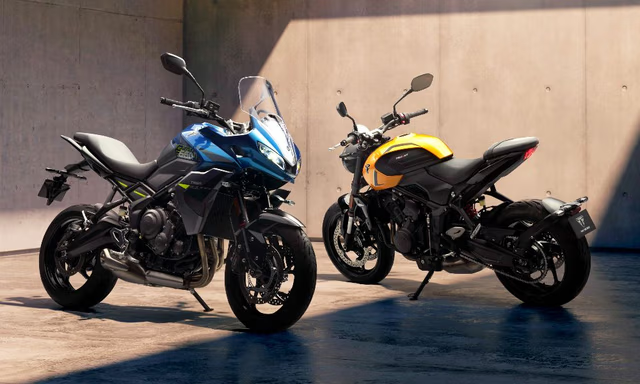 Janak Sorap | Jan 21, 20262026 Triumph Trident 660 and Tiger Sport 660 Unveiled; India Launch This YearBased on the setup offered on the Daytona 660, this is the most comprehensive update the Trident and Tiger Sport has received since their introduction.3 mins read
Janak Sorap | Jan 21, 20262026 Triumph Trident 660 and Tiger Sport 660 Unveiled; India Launch This YearBased on the setup offered on the Daytona 660, this is the most comprehensive update the Trident and Tiger Sport has received since their introduction.3 mins read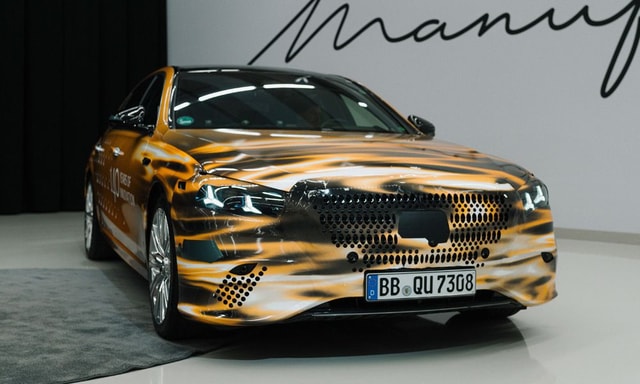 Jaiveer Mehra | Jan 21, 2026New Mercedes-Benz S-Class Previewed Ahead Of Jan 29 Global DebutMercedes says that over 50 per cent of the parts in the upcoming S-class are new, with the car also set to be L4 autonomous driving ready.3 mins read
Jaiveer Mehra | Jan 21, 2026New Mercedes-Benz S-Class Previewed Ahead Of Jan 29 Global DebutMercedes says that over 50 per cent of the parts in the upcoming S-class are new, with the car also set to be L4 autonomous driving ready.3 mins read car&bike Team | Jan 21, 20262026 Jeep Meridian Updated With Sliding Second Row Seats; Prices Start At Rs. 23.33 LakhThe update is limited to select three-row variants of the Jeep Meridian, namely, Limited and Overland.1 min read
car&bike Team | Jan 21, 20262026 Jeep Meridian Updated With Sliding Second Row Seats; Prices Start At Rs. 23.33 LakhThe update is limited to select three-row variants of the Jeep Meridian, namely, Limited and Overland.1 min read Jaiveer Mehra | Jan 21, 2026Skoda Kylaq Classic+, Prestige+ Prices RevealedSkoda has also confirmed a new Sportline variant that will join the lineup later in the year.1 min read
Jaiveer Mehra | Jan 21, 2026Skoda Kylaq Classic+, Prestige+ Prices RevealedSkoda has also confirmed a new Sportline variant that will join the lineup later in the year.1 min read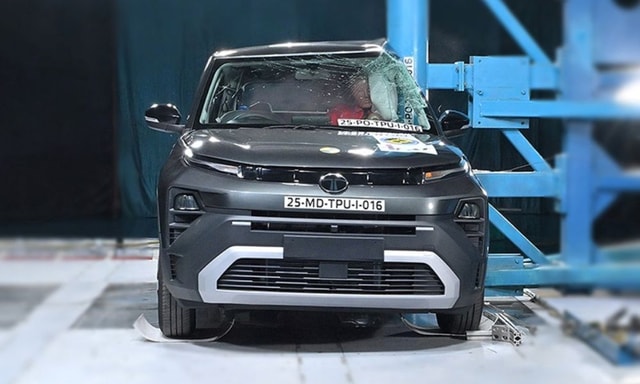 Jaiveer Mehra | Jan 20, 2026Tata Punch Facelift Bharat NCAP Crash Test Scores Revealed; Gets 5-Star RatingFacelifted internal combustion Punch secures 30.58 out of 32 for adult occupant protection and 45 out of 49 for child occupant protection.1 min read
Jaiveer Mehra | Jan 20, 2026Tata Punch Facelift Bharat NCAP Crash Test Scores Revealed; Gets 5-Star RatingFacelifted internal combustion Punch secures 30.58 out of 32 for adult occupant protection and 45 out of 49 for child occupant protection.1 min read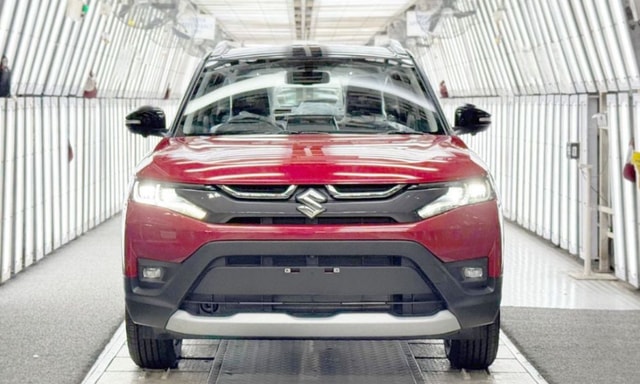 Seshan Vijayraghvan | Jan 20, 2026Maruti Suzuki To Invest Rs. 35,000 Crore For Setting Up New Manufacturing Plant In GujaratThe new facility will come up in Khoraj, on 1,750 acres of land provided by Gujarat Industrial Development Corporation (GIDC).2 mins read
Seshan Vijayraghvan | Jan 20, 2026Maruti Suzuki To Invest Rs. 35,000 Crore For Setting Up New Manufacturing Plant In GujaratThe new facility will come up in Khoraj, on 1,750 acres of land provided by Gujarat Industrial Development Corporation (GIDC).2 mins read
 Bilal Firfiray | Jan 21, 2026Tata Punch Facelift Review: New Turbo Engine; Same Old SoulWith the update, the Tata Punch facelift retains its character of being a healthy runabout, which is perfect for Indian roads. But have these changes made it any better?7 mins read
Bilal Firfiray | Jan 21, 2026Tata Punch Facelift Review: New Turbo Engine; Same Old SoulWith the update, the Tata Punch facelift retains its character of being a healthy runabout, which is perfect for Indian roads. But have these changes made it any better?7 mins read Amaan Ahmed | Jan 17, 2026Bajaj Chetak C25 First Ride Review: Basic, Likeable E-Scooter For First-Time RidersThe Chetak C25, in quite a few ways, is poles apart from the larger and more powerful 30 and 35 Series models, but in its mannerisms, it is very much a Chetak.8 mins read
Amaan Ahmed | Jan 17, 2026Bajaj Chetak C25 First Ride Review: Basic, Likeable E-Scooter For First-Time RidersThe Chetak C25, in quite a few ways, is poles apart from the larger and more powerful 30 and 35 Series models, but in its mannerisms, it is very much a Chetak.8 mins read Bilal Firfiray | Jan 9, 2026Toyota Urban Cruiser Hyryder: 10,000 km Long-Term ReviewAfter spending over three months and 10,000 km with the Toyota Urban Cruiser Hyryder Hybrid, we were impressed by its real-world mileage, seamless hybrid, practical comfort, and Toyota reliability. Is it the best C-SUV then?5 mins read
Bilal Firfiray | Jan 9, 2026Toyota Urban Cruiser Hyryder: 10,000 km Long-Term ReviewAfter spending over three months and 10,000 km with the Toyota Urban Cruiser Hyryder Hybrid, we were impressed by its real-world mileage, seamless hybrid, practical comfort, and Toyota reliability. Is it the best C-SUV then?5 mins read Seshan Vijayraghvan | Jan 8, 20262026 Mahindra XUV 7XO Review: Big On Tech, Bigger On ComfortThe new Mahindra XUV 7XO is flashier, feature packed, and comes with more advanced tech. But are the changes just incremental or actually substantial?1 min read
Seshan Vijayraghvan | Jan 8, 20262026 Mahindra XUV 7XO Review: Big On Tech, Bigger On ComfortThe new Mahindra XUV 7XO is flashier, feature packed, and comes with more advanced tech. But are the changes just incremental or actually substantial?1 min read Preetam Bora | Jan 10, 2026Simple One Gen 2 First Ride Review: 265 km Claimed Range!The Gen 2 model of Simple Energy’s first electric scooter gets a fair few updates, including new features, tech, more range and lighter weight. We spent a couple of hours with the Simple One Gen 2 to find out if it manages to impress.6 mins read
Preetam Bora | Jan 10, 2026Simple One Gen 2 First Ride Review: 265 km Claimed Range!The Gen 2 model of Simple Energy’s first electric scooter gets a fair few updates, including new features, tech, more range and lighter weight. We spent a couple of hours with the Simple One Gen 2 to find out if it manages to impress.6 mins read












































































































































